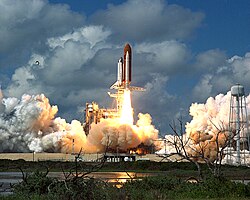 TDRS-C aboard Discovery | |
| Mission type | Communication |
|---|---|
| Operator | NASA |
| COSPAR ID | 1988-091B |
| SATCAT no. | 19548 [1] |
| Mission duration | Planned: 10 years Elapsed: 37 years, 3 months, 3 days |
| Spacecraft properties | |
| Bus | TDRS |
| Manufacturer | TRW |
| Launch mass | 2,224.9 kg (4,905 lb) [2] |
| Dimensions | 17.3 × 14.2 m (57 × 47 ft) [2] |
| Power | 1700 watts [2] |
| Start of mission | |
| Launch date | 29 September 1988, 15:37:00 UTC |
| Rocket | Space Shuttle Discovery STS-26 / IUS |
| Launch site | Kennedy Space Center LC-39B |
| Contractor | Rockwell International |
| Orbital parameters | |
| Reference system | Geocentric orbit |
| Regime | Geostationary orbit |
| Longitude | 151° West (1988) 171° West (1988–1990) 174° West (1990–1991) 62° West (1991–1994) 171° West (1994–1995) 85° East (1995–2009) 49° West (2009–) |
| Epoch | 29 September 1988 [3] |
TDRS-3, known before launch as TDRS-C, is a first-generation American communications satellite, which is operated by NASA as part of the Tracking and Data Relay Satellite System. It was constructed by TRW and is based on a custom satellite bus, which was used for all seven first-generation TDRS satellites. [4]



